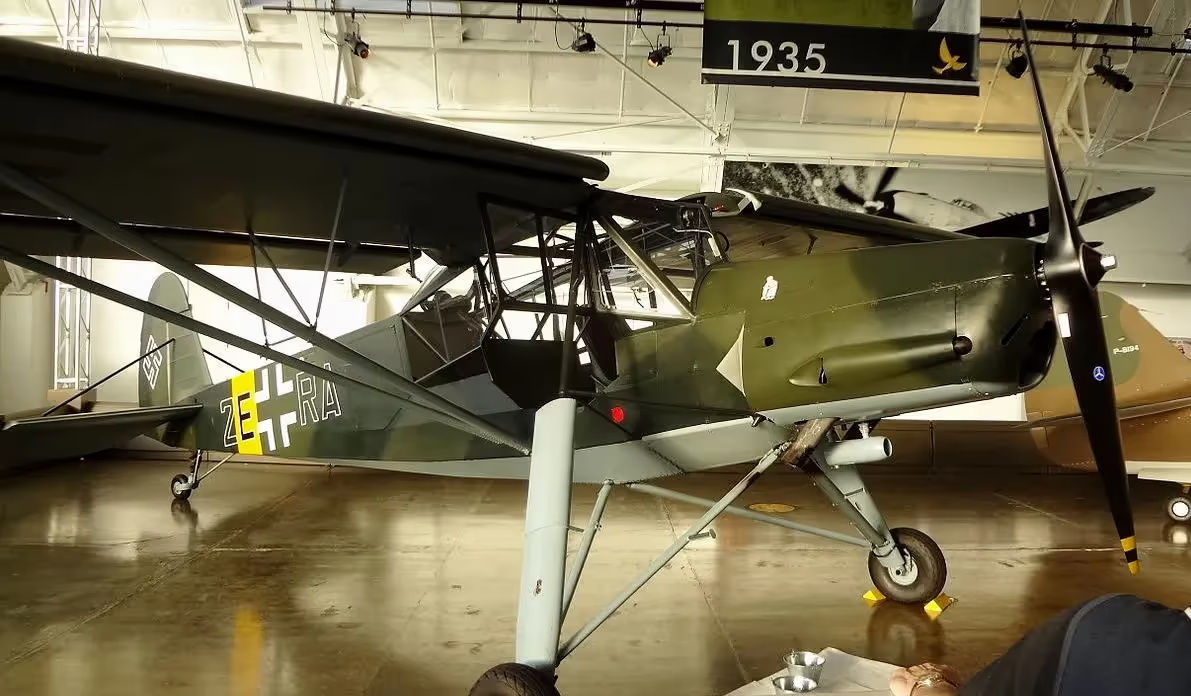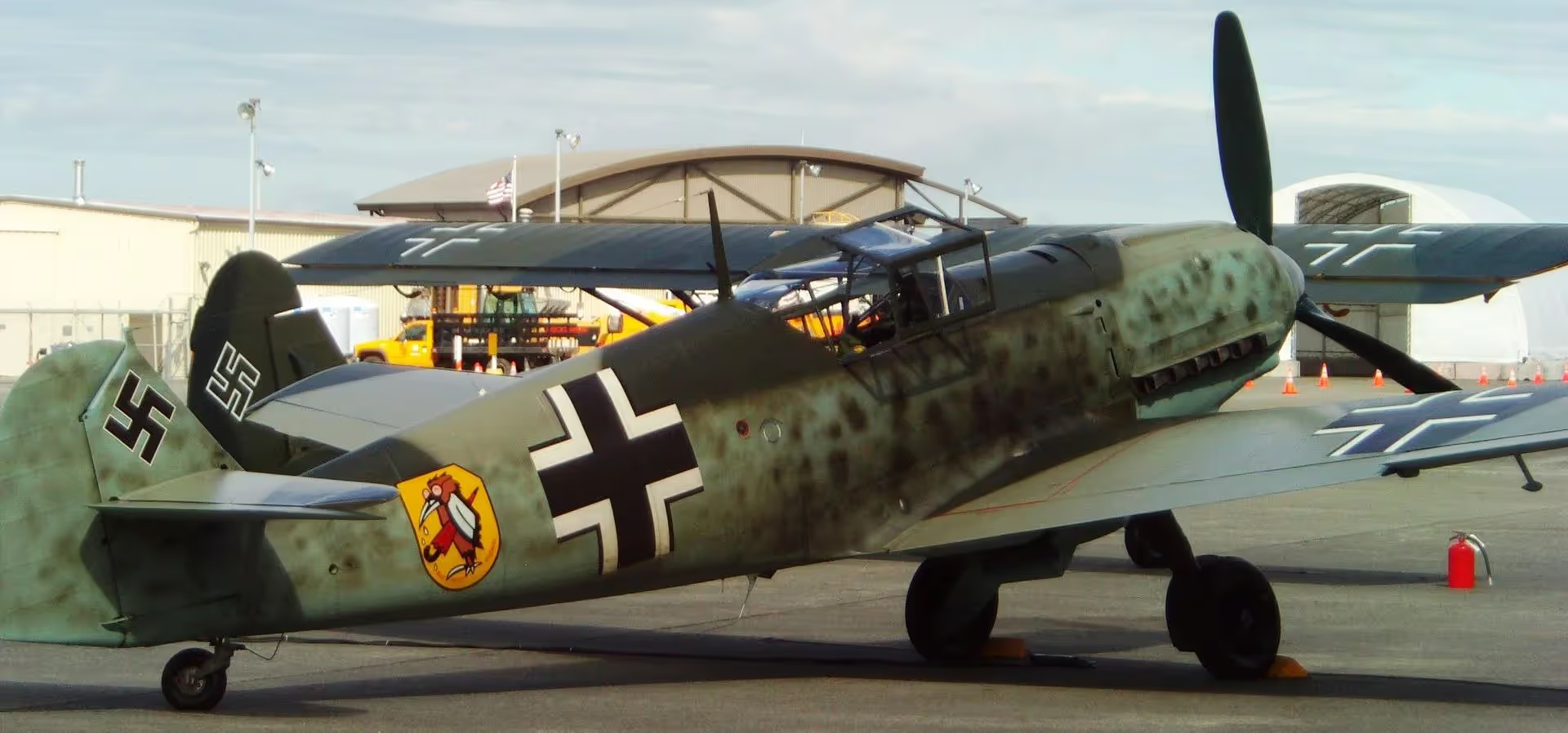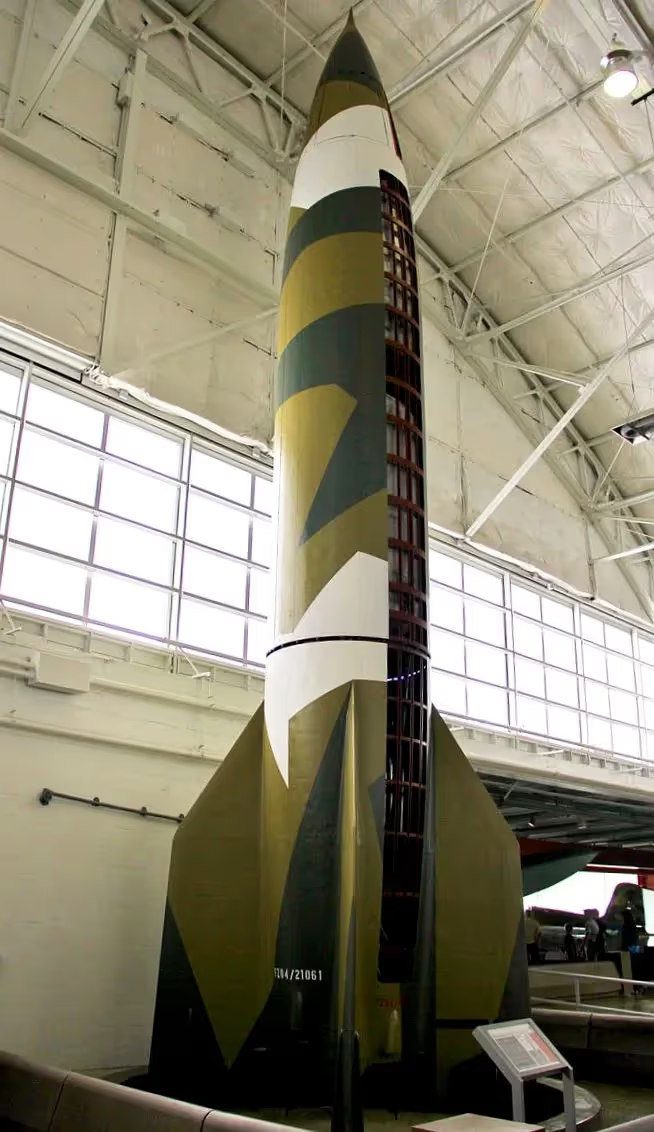Warplanes of the USA: Washington, Everett, Flying Heritage & Combat Armor Museum
Washington, Everett, Wartime History Museum
Paine Field, 3407 109th St SW, 98204. www.flyingheritage.com. On 4 August 2022, the Flying Heritage and Combat Armor Museum collection assembled by Paul Allen, was sold to the Wartime History Museum, a new non-profit organization established by Steuart Walton (an experienced warbird owner and pilot). The Flying Heritage & Combat Armor Museum is a 501c(3) nonprofit organization dedicated to the display and preservation of rare military aircraft, tanks and other military equipment. On rotation in the three working hangars are military artifacts from the United States, Britain, Germany, Soviet Union and Japan. The Flying Heritage & Combat Armor Museum is housed in three working hangars on Paine Field in Everett, WA. Mechanics are typically on-site Monday through Friday working on maintaining the technology to operating condition. The museum provides guided tours seven days and features 90" touch-screens, combat simulators and life-size replicas. The museum also features an exhibition of parachuting dogs, rare animal artifacts and animals participating in armed conflicts. In 1998, Paul Allen began acquiring and preserving vintage aircraft. Allen's passion for aviation and history, and his awareness of the increasing rarity of original World War II aircraft, motivated him to restore these artifacts to the highest standard of authenticity and share them with the public. The Collection opened to the public in 2004 at the Arlington, Washington, airfield, but in 2008 moved to a newly renovated historic industrial hangar located at Paine Field in Everett, Washington, United States. In 2013, the Flying Heritage & Combat Armor Museum added a 22,000 square foot expansion hangar for its expanding collection. In 2018 came another expansion featuring the opening of Hangar C which added over two dozen additional artifacts. On March 24, 2017 the Museum changed its name from the Flying Heritage Collection to the Flying Heritage & Combat Armor Museum to reflect the transition from exclusively aircraft to a military vehicle & history Museum. In 2018, the Flying Heritage & Combat Armor Museum became a public 501c(3) nonprofit.

(Goshimini Photo)
Avro 683 Lancaster B1 nose section, RAF (Serial No. TW911).
.webp)
(Eric Friedebach Photo)
Bell X-1 "Glamorous Glennis". Replica.
Chance Vought F-8L Crusader, (BuNo. 145527), c/n A35-30, previously flown by Thunderbird Aviation Inc, Reg. No. N37TB.
.webp)
(Eric Friedebach Photo)
Curtiss JN-4D Jenny (Serial No. 3712), C/N 3712, Reg. No. N3712.

(Ken Fielding Photo)

(Articseahorse Photo)
Curtiss P-40C Tomahawk (Serial No. 41-13390), C/N 16194, “O’Reily’s Daughter”, Reg. No. N2689.
de Havilland DH.98 Mosquito T.III (Serial No. TV959), ZK-FHC, airworthy. This aircraft has been repainted to represent F.B.VI (Serial No. NS838), UP-J of RAF No. 605 Squadron. Built in 1945 as a trainer, it was retired from RAF service in 1963. It appeared in the 1964 film "633 Squadron".

(PanGalacticGargleBlasterr Photo)
Fieseler Fi-156C-2 Storch C/N 4362, 2E-RA, Reg. No. N436FS.

(Articseahorse Photo)

(Goshimimi Photo)
Fieseler Fi-103 V-1 Flying Bomb.

(Goshimimi Photo)

(Articseahorse Photo)
Fieseler Fi-103R-IV, Reichenberg IV (Serial No. 44329), C/N 44329.

(PanGalacticGargleBlaster Photo)

(Goshimini Photo)

(Clemens Vasters Photo)

(John Veit Photo)
Focke-Wulf Fw 190A-5/U-3 (Serial No. 151227), A, C/N 151227, Reg. No. N19027. This is the only original-build still airworthy Fw 190 in the world.

(PanGalacticGargleBlasterr Photo)

(Goshimini Photo)
Focke-Wulf Fw 190D-13, (Wk. Nr. 836017), 10, Reg. No. N190D.
Goodyear FG-1D Corsair (BuNo. 88303), 523, USMC VMF-115, FW, Reg. No. N700G, Vulcan Warbirds. Airworthy.

Grumman F6F-3N Hellcat night fighter with AN/APS-6 radar and two 20-mm MN2 cannon, NAS Jax, 1943. (USN Photo)

(Articseahorse Photo)

(John Veit Photo)
Grumman F6F-5K Hellcat (BuNo. 79863), 00, C/N A-11008, Reg. No. N79863.

Hawker Sea Hurricanes in formation. (Imperial War Museum Photo A9534)

(John Veit Photo)

(Goshimini Photo)
Hawker Sea Hurricane Mk. XIIA, RCAF (Serial No. 5429), coded Z, built by Canadian Car and Foundry CCF, c/n R32007, Reg. No. NX54FH. Previously RAF (Serial BW881), UK Reg. No. G-KAMM.

(John Veit Photo)

(Articseahorse Photo)
Ilyushin Il-2M3 Shturmovik, C/N 305401, 2, Reg. No. NX112VW.
Junkers Ju 87R-4 Stuka (Wk. Nr. 6234), coded L1+FW, built in 1941, this Stuka served with Lehrgeschwader 1 and later Sturzkampfgeschwader 5. This Stuka was on a missoin to bomb Murmansk in northern Russia on 24 Apr 1942 when it was brought down by Soviet fighters. The wreckage was recovered in the early 1990s and passed through several hands before being acquired by the museum. It is currently undergoing restoration to make it airworthy.

Lockheed P-38J Lightning (Serial No. 43-68008). (USAAF Photo)

Lockheed P-38J Lightning, crew using a heater, Florenes, Belgium, Feb 1945. (USAAF Photo)
Lockheed P-38J-15-LO Lightning (Serial No. 42-104088), c/n 2922, Reg. No. N38LL. This aircraft has been sold, current location to be determined.

(Clemens Vasters Photo)

(Goshimini Photo)


(John Veit Photos)
Messerschmitt Bf 109E-3, C/N 1342, Reg. No. NX342FH.

(Articseahorse Photo)
Messerschmitt Me 163B-1a Komet, (Wk. Nr. 191660), C/N 191660, 3.
Messerschmitt Me 262 A-1a/U3, (Wk. Nr. 500453). This aircraft is being restored to airworthy condition.



(USAAF Photos)
Messerschmitt Me 262A-1a/U3 (Wk. Nr. 500453), coded "White 25", reconnaissance version modified with bulges on the nose to accommodate film magazines for two Rb 20/30 cameras. U3 (Umrüst-Bausatz 3, Factory Modification Kit No. 3).
By the war’s final months, Allied bombing efforts in Germany had so disrupted aircraft production that most formal factories were essentially non-functional. Instead, aircraft production took place in improvised locations such as road tunnels, caves and even forests. Wk. Nr. 500453 went through final assembly in a waldwerk, or ‘forest factory’, in Obertraubling, near Regensburg, Germany in March, 1945. The completed aircraft was moved some 200 km south, presumably by rail, to Memmingen where Messerschmitt factory pilot Sergeant Otto Kaiser flew the aircraft for the first time on 14 March 1945. Following flight testing, the plane transferred to Eger, where it underwent conversion from a fighter into an unarmed photo-reconnaissance variant, with two Rb 20/30 vertical cameras in the nose compartment, instead of 30-mm cannon.
According to the Flying Heritage & Combat Armor Museum (FHCAM), "these planes were unarmed and relied on speed and altitude to avoid tangling with Allied fighters. At the Lechfeld airfield, the plane came under the jurisdiction of the 54th Air Disarmament Squadron (ADS) of the U.S. Army in May of 1945. The German crosses on the sides of the plane were painted over with a United States roundels and bars. The swastika at the tail was also painted over. These aircraft were acquired by the USA as part of Operation Lusty; a mission to gain access to enemy aircraft, technical and scientific reports, research facilities, and weapons.” LCol Harold Watson led the flight team within Operation Lusty. Better known as “Watson’s Whizzers” these pilots gathered enemy aircraft of technical interest from across the fallen Nazi empire.
Prior to the arrival of Watson's team, Master Sergeant Preston of the 54th Air Disarmament Squadron named this plane "Connie ...My Sharp Article" (after his wife). "White 5" became Watson's Whizzers 444, and was ferried to Melun, France by Lt Roy Brown, who renamed it "Pick II" (after a nickname derived from his wife's maiden name). Brown ferried the jet to the port of Cherbourg, France, where it was loaded onto the British escort carrier HMS Reaper. While on the deck of the HMS Reaper, it was allocated inventory control No. 19. After arrival at Newark, Watson ferried 444 to Freeman Field, Indiana on 19 August, 1945. There, the Army Air Force assigned "White 5" a Foreign Equipment number, FE-4012. This was later changed to T2-4012. This aircraft was selected to participate in classified tests against the Lockheed P-80, and underwent a nose section changeup with Watson's Whizzers 888, later FE-111. The machine was given an overall reconditioning for the tests.
“On the 17th of May 1946 Colonel Watson flew the aircraft to Patterson Field for the start of this series of trials. It was flown at Patterson and Wright Fields on test work for 4 hours and 40 minutes (8 flights), being flyable at Wright Field in August 1946. Flight trials were discontinued after four engine changes were required during the course of the tests, culminating in two single-engine landings. Around 1955, the plane (now in fairly rough shape) was acquired by Edward T. Maloney for his Planes of Fame Air Museum, then at Claremont, California. The museum later moved to Ontario, California and finally Chino, California. The plane stayed in the museum’s collection for many years, undergoing one or more restorations. On display, the plane was marked in a “White Nine” colour scheme copied from a photograph of another aircraft, which was scrapped on a dump near Munich following the war.”
"White 5" was with the Planes of Fame Museum in California before being transferred to Paul Allen's FHCAM in Washington State in 2010. It has undergone and extensive restoration and is registered as N9450. Painted as "Red 25" it is expected to be taken up for a test flight in 2019. Current plans only extend to one flight, with the aircraft likely being grounded once it goes on display within the museum’s home at Paine Field in Everett, Washington.




(USAAF Photos)
Messerschmitt Me 262A-1a/U3 (Wk. Nr. 500453), "White 25", reconnaissance version modified with bulges on the nose to accommodate film magazines for two Rb 20/30 cameras. U3 (Umrüst-Bausatz 3, Factory Modification Kit No. 3). Prior to the arrival of Watson's team, Master Sergeant Preston of the 54th Air Disarmament Squadron named this plane "Connie ...My Sharp Article" (after his wife). "White 5" became Watson's Whizzers 444, and was ferried to Melun, France by Lt Roy Brown, who renamed it "Pick II" (after a nickname derived from his wife's maiden name). Brown ferried the jet to the port of Cherbourg, where it was loaded onto the British escort carrier HMS Reaper. While on the deck of the HMS Reaper, it was allocated inventory control No. 19. After arrival at Newark, Watson ferried 444 to Freeman Field, Indiana on 19 August, 1945. There, the Army Air Force assigned "White 5" a Foreign Equipment number, FE-4012. This was later changed to T2-4012. This aircraft was selected to participate in classified tests against the Lockheed P-80, and underwent a nose section changeup with Watson's Whizzers 888, later FE-111. The machine was given an overall reconditioning for the tests. "White 5" was with the Planes of Fame Museum in California before being transferred to Paul Allen's Flying Heritage & Combat Armor Museum in Washington State. There are plans to restore this aircraft to flying status, and it is registered as N9450, painted as "White 9".
This Me 262 is currently at Moses Lake, Washington, where it was restored to the point where it was taxiied by Steve Hinton, the scheduled pilot from POF in Chino, California. (Randy Malmstrom)

(Articseahorse Photo)
Mikoyan-Gurevich MiG-29UB Fulcrum, C/N 50903014896, 64, Reg. No. N29UB. This aircraft has been sold, location to be determined.


(Ken Fielding Photos)

(John Veit Photo)

(Goshimini Photo)


(Articseahorse Photos)
Mitsubishi A6M3 Model 22 Reisen (Zero), UI-161, C/N 3852, Reg. No. N3852.
Mitsubishi A6M3 Model 22 Reisen (Zero), S-112, C/N 3148. Being restored to airworthy status. "Ghost Zero" has been sold to Legend Flyers, Everett, WA, who have restored the aircraft to flying condition. Reg. No. NX9949.

(Goshimini Photo)
Mitsubishi A6M5-52 Reisen (Zero), HK-102, c/n 4400, Reg. No. N652Z. Previously with Planes of Fame.



(Articseahorse Photos)
Nakajima Ki-43-Ib Hayabusa, (Oscar), C/N 750, Reg. No. N750N.

(Ken Fielding Photo)
North American B-25J Mitchell, C/N 108-33529, 810-A, Reg. No. N41123.


(John Veit Photos)
North American P-51D-20NA Mustang (Serial No. 44-72364), SX-L, C/N 122-38823, ex-Swedish Air Force (Serial No. Fv260061), ex-Dominican Sir Force (Serial No. FAD 1916), LS-X, “Upupa Epops”, Reg. No. N723FH. Issued to the 353rd Fighter Group based at Raydon, Suffolk, England during the Second World War. Flown by Lt Harrison Tordoff with the 352nd Fighter Squadron early in 1945. Among his nine kills Lt Tordoff downed a Messerschmitt Me 262.
Northrop F-5B Freedom Fighter C/N N9006, Reg. No. N586PC.

(Articseahorse Photo)

(N Simpson Photo)
Polikarpov Po-2, C/N 641543, 23, Reg. No. NX46GU.

(N Simpson Photo)

(Goshimini Photo)

(Articseahorse Photo)
Polikarpov I-16 Type 24 Rata, C/N 2421014, Reg. No. NX7459.

(John Veit Photo)

(Articseahorse Photo)
Republic P-47D Thunderbolt (Serial No. 45-49406|), manufactured by Republic Aviation in Evansville, Indiana (USA), and delivered to the USAAF on 27 June 1945. It was placed in storage until March 1948, when it was assigned to an U.S. Air National Guard squadron. The aircraft is is painted in the colours of the "Tallahassee Lassie", P-47D-30-RA (Serial No.n 44-33133), flown by Seattle-born Colonel Ralph C. Jenkins. He led the 510th Fighter Squadron, 405th Fighter Group, USAAF. It was previously employed by the Brazilian Air Force, and spent some time as a monument on a pedestal.

(Ken Fielding Photo)


(Alan Wilson Photos)
Supermarine 349 Spitfire LF Mk. 5c, RAF (Serial No. AR614), DU-Z, RAF 301 Sqn, C/N WASP/20/288, Reg. No. N614VC. (Ken Fielding Photo 1, 5shot Photo 2)

(Clemens Vasters Photo)
V-2 Rocket, Mittelwerk.
Tanks
The collection features a variety ofvehicles and armament dating from WWII to some present-day artifacts. Most ofthe artifacts are from the United States, Germany, Japan, and the Soviet Union.
United States
M1A1 Abrams turret trainer
M48A1 Patton (Cut in Half)
M4A1 Sherman
M5A1 Stuart
M60A1 Patton
M24 Chaffee
M7B1 Priest
M8 Greyhound
M26 Pershing
.webp)
(Eric Friedebach Photo)
M55 self-propelled howitzer
United Kingdom
Churchill Mk VII Crocodile
Soviet Union
_T-34_85_(8095573344).webp)
(Eric Friedebach Photo)
FMDB T-34/85
T-54M
.webp)
(Eric Friedebach Photo)
R-11M with 8U218 TEL (SS-1b Scud A) Ballistic Missile System
Germany
__Hetzer__(8095568625).webp)
(Gillfoto)
Jagdpanzer 38(t) (Hetzer).
Panzerkampfwagon IV Ausf. H
Japan
Type 95 Ha-Go
Artillery
United States
M2 155mm "Long Tom" field gun
United Kingdom
17-Pounder Mk. I anti-tank gun
Germany
75mm PaK 40 anti-tank gun
88mm Flak 37 anti-aircraft gun
Japan
47mm Type 1 anti-tank gun
Armoured Fighting Vehicles
United States
M5A4 high-speed tractor
AM General M936A2 wrecker
Dodge WC24 command car
Dodge WC54 ambulance
Ford GPW "Jeep"
Harley-Davidson WLA
Landing craft, vehicle, personnel (LCVP)
M3A1 half-track personnel carrier
M274A5 Mule
Germany
BMW R75
Opel Super 6
Scheuch-Schlepper
Volkswagen Kubelwagen Typ 82 Kfz.1





